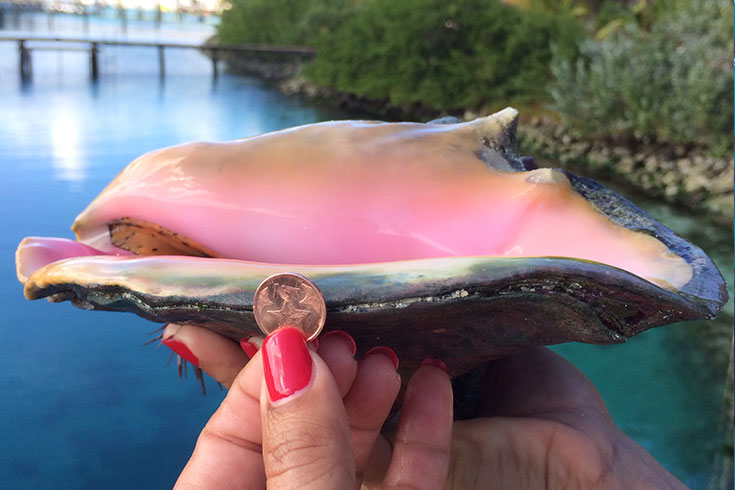With so many marine educators excited about the country’s newest – and possibly catchiest – environmental protection initiative, it would only be fitting for the Dolphin Encounters team to share some information about the Bahamas National Conchservation Campaign and the Queen Conch.
Considered one of The Bahamas’ national dishes, conch has long been an important part of our marine life and fisheries industry. However, while most local restaurants offer dishes featuring the mollusk, its popularity has led to a significant decline in Queen Conch numbers around the country.
Overfishing and poaching are made easy by the conch’s natural habitat – shallow, grassy waters – and its lengthy maturation periods. During its first year of life, the conch lives under the sand, venturing out only at night to feed. As it ages, the conch develops its shell from calcium carbonate found in the sea; every year, the sea snail adds a new spiral to its shell, boosting its defenses against predators and enhancing its home’s natural beauty.
When the conch reaches maturity at approximately 6 years old, it is capable of reproducing; a Queen Conch can produce a single egg mass containing hundreds of thousands of eggs, and may breed up to nine times every year, but chances of survival are low – only one of 500,000 eggs from a single egg mass will reach maturity.
These odds have become even more apparent through recent research conducted by Community Conch, which asserts that our current national regulations governing conch harvest may not be sufficient to ensure the species’ survival. The regulations presently allow for a conch to be harvested when its shell has a well-formed flared lip; however, Community Conch’s studies suggest that, unless the lip is at least 15 mm thick – or the size of the new Bahamian penny, the conch is probably a juvenile.
With one of the country’s most iconic foods and symbols at risk of extinction, Bahamian activists have been gaining support from the public – particularly the arts community. Lending a helping and gifted hand, local artist Antonius Roberts has contributed to the Conchservation efforts with his “Tree of Trees” piece – an installation featuring conch shells collected from discarded conch shell piles around New Providence.
Nearly 200 shells were collected for the installation with more than half of them featuring lips with widths measuring less than 15mm. The piece is a startling reminder of the danger posed to the conch population by unsustainable fishing practices that do not support the maturation and breeding of the Queen Conch.
Members of the public who want to get involved in the Conchservation Campaign are encouraged to check out the My Science, My Conch program, which gives participants training in conducting supervised surveys of conch shell piles.


